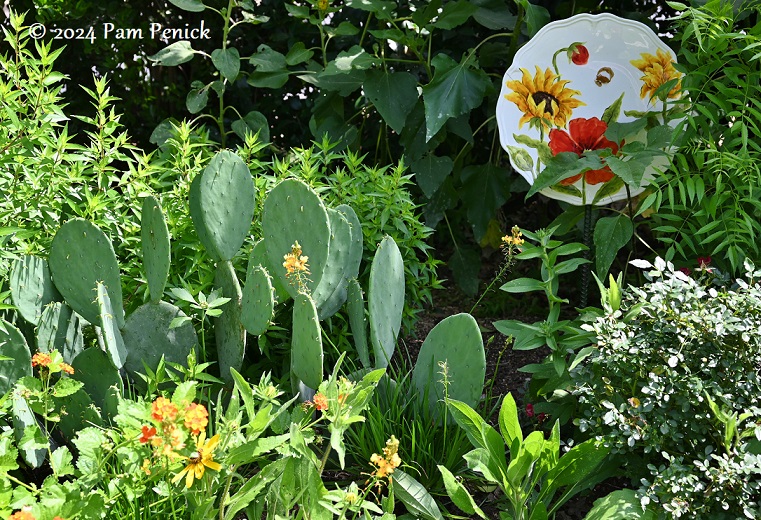May 06, 2024
A year ago I received an invitation to visit a unique garden in Blanco, a small town an hour west of Austin in the Texas Hill Country. Because I was working nonstop on my book, I took a rain check until this spring. Recently I drove out with a friend to meet the owner, James Robinson, and see what he and his wife, Nancy, have created on their rural property.

James met us outside his walled-and-deer-fenced garden, which is located near the road — a surprising distance from their house. To reach their house, you continue along their winding driveway perhaps a quarter-mile, past a picturesque old barn and groves of live oaks.
It’s not exactly the backyard.
But I can see why James and Nancy made their garden in this spot. Limestone walls — the roofless structure of a sturdy sheep pen built 100 years ago — enclose the garden on three sides, providing protection from winter winds, a picturesque backdrop, and a connection to the property’s ranching history.

The walls give a feeling of age to the 12-year-old garden. They also create a house-like corner where an actual bed is made up with coverlet and pillows. I asked James if he ever sleeps out here. “We don’t nap on it,” he said, “but we do use it when it’s cold and the fire pit is going.” He told me it’s usually covered with a drop cloth, but they make it up for visitors. An old screen door leaning against the wall keeps the bed company, adding a dash of red echoed by Adirondack chairs and a flowering crossvine.

Flanking the gate into the garden stand two spent agaves. One still holds its towering bloom stalk aloft — a final burst of growth for a mature agave, which dies after flowering.
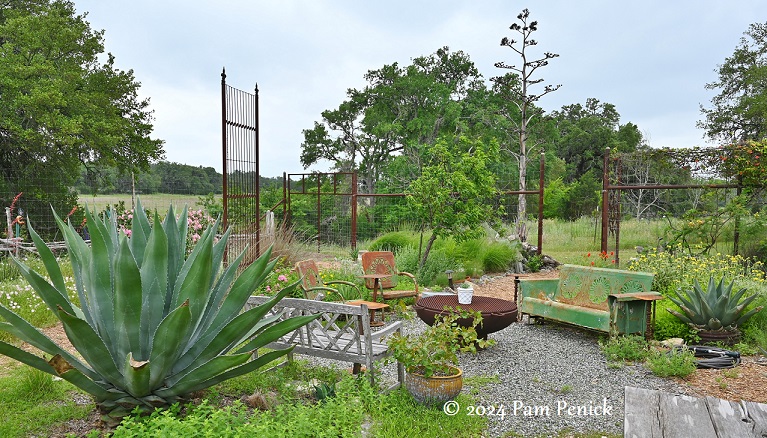
The gate opens onto a patio surrounded by agaves, roses, and Jerusalem sage. Vintage metal chairs and a glider, patinaed with green paint, encircle a steel fire pit.

Glittering crushed glass subs for gravel paving here. It reminds me of gardens in Austin (like this one and this one) that incorporated recycled glass back when Austin offered crushed glass for free. (It no longer does.)

The old motel-style chairs exude country charm.

As does a drink table made from a rusty camshaft.

A stone rabbit peeks out from a patch of Jerusalem sage.
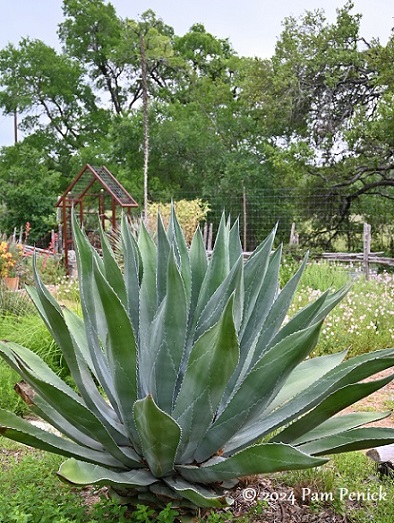
A big old agave that somehow survived Snowpocalypse holds court by the fire pit with leaves like green flames.

On a picnic table near the fire pit, a yellow-green table runner…

…turned out to be a built-in planter of succulents and cacti!

A wider view

In the heart of the garden stands a faded red shed with corrugated barn doors on each side.

Paths meet up with it from all sides.

Its doorways frame an axis view to another gabled structure, a rusty arbor in the distance.

Passing through the shed, I stopped to admire a whimsical blue chandelier hanging inside.
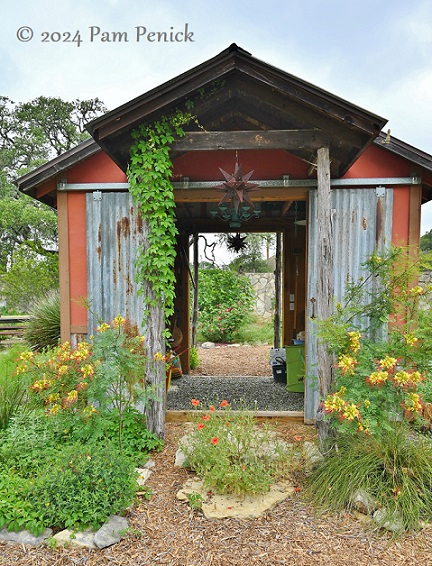
Hardy bird-of-paradise (Caesalpinia gilliesii) frames the doorway on the other side.

When I posted a photo of this plant to my Facebook page last week, it blew up with comments. Everyone wanted to know more about it. The botanical name is Caesalpinia gilliesii, and its common name is hardy or desert bird-of-paradise. Yes, it’s related to Pride of Barbardos (Caesalpinia pulcherrima), which has similar flowers that are orange and red, not yellow and red.
By the way, there’s also a yellow bird-of-paradise (Caesalpinia mexicana), which is native to the Rio Grande Valley — i.e., not reliably winter hardy in Central Texas. Tropical bird-of-paradise (Strelitzia reginae) is altogether different and definitely not hardy here.
If you’re hunting for James’s hardy bird-of-paradise, be sure to request it by its botanical name so you get the right one: Caesalpinia gilliesii. He says Wimberley Gardens told him they’d be getting some in soon.
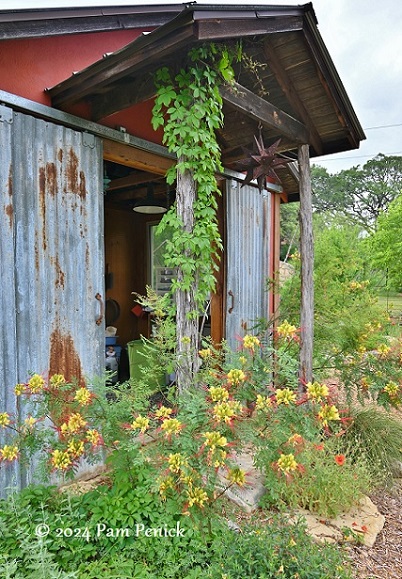
Caesalpinia gilliesii was already in full bloom when I visited in late April — weeks ahead of Pride of Barbados.
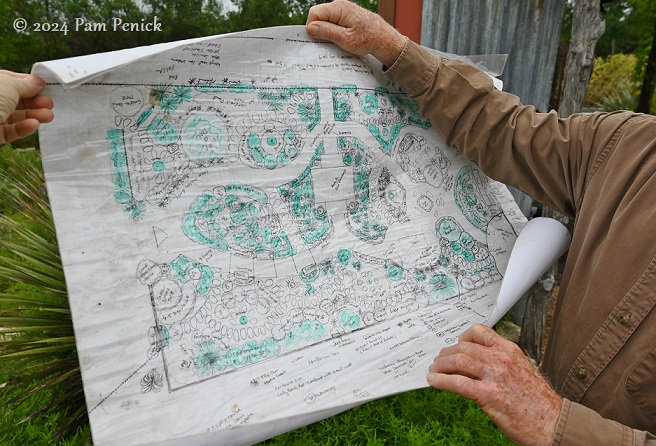
When we reached the shed, James extracted a rolled-up paper from a shelf and unfurled it to show us the garden’s original design, drawn up by Lucy Harrell. Lucy taught an organic gardening and design class that James and Nancy took while living in Arlington. “As part of the class,” says James, “a small landscape plan was included. This was a little more than Lucy intended, but she agreed to come down from Arlington to help us. We had margaritas and worked on it together. She was wonderful. She had a wonderful garden in Arlington, but she has since moved to Magnolia.”

James talking with my friend Cat, who accompanied me to Blanco
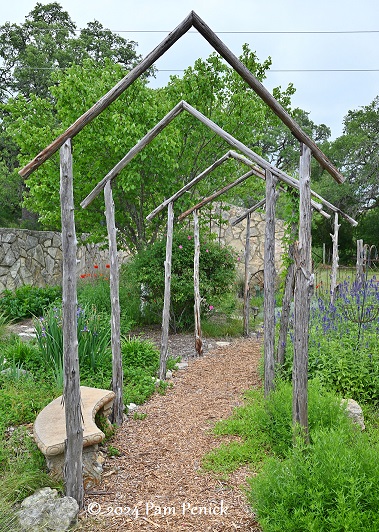
Cedar arbors march away from the shed along a mulched path…
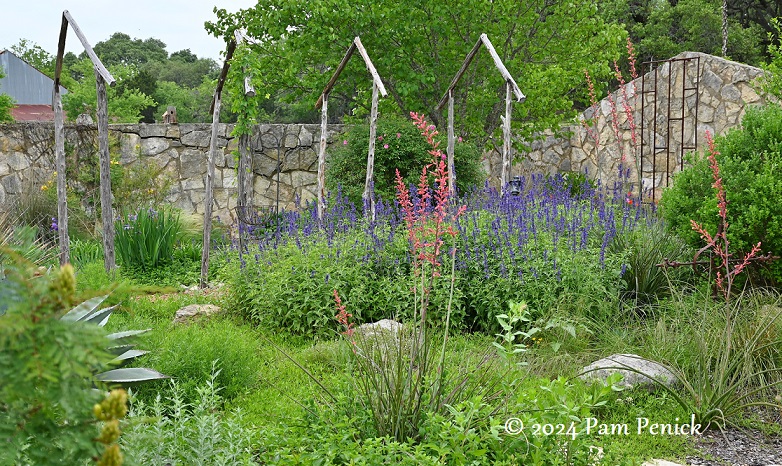
…and echo the triangular gable of the stone wall.

Along the way you pass irises…
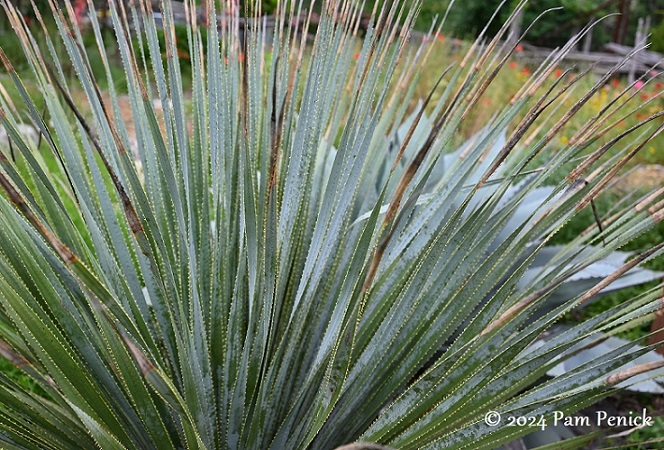
…and toothy Wheeler’s sotol.

Looking back

Salvia — mealy blue sage, I think

Whale’s tongue agave

And poppies

Bees and a hoverfly were all over the poppies.
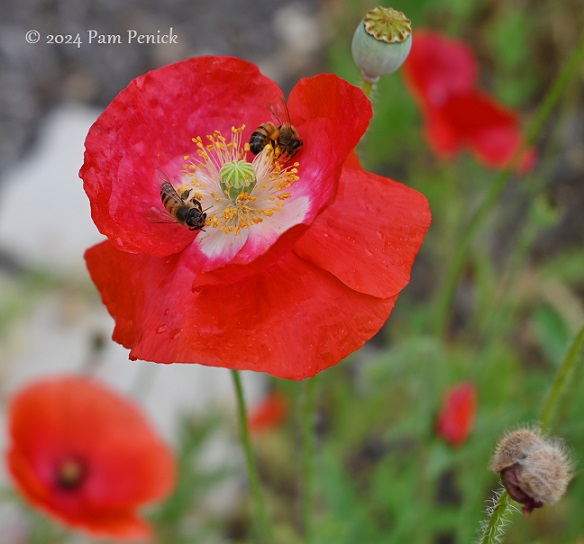
Intent on their work

In a bushy patch of pink evening primrose, a bike ornament nods to James’s love of cycling.
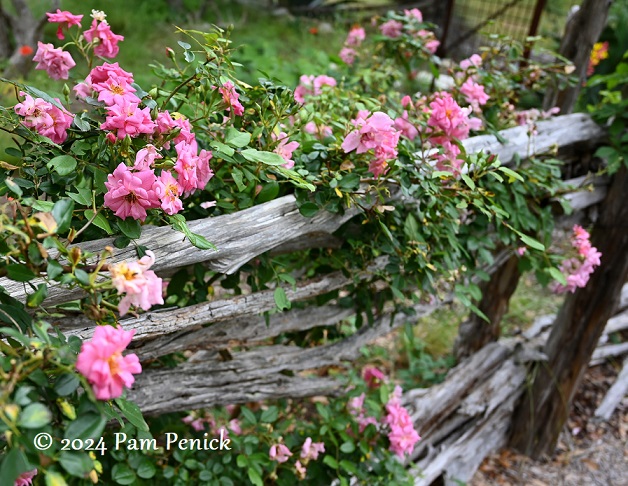
A pink rose rambles along a weathered cedar fence at the back of the garden. The fence is old — it was here when James and Nancy acquired the property. James wonders if it could possibly be the same age as the sheep-pen walls and the big barn, where a concrete footing is etched with the date 1926.

Within the fenced area, Nancy grows vegetables like asparagus and chard in elevated stock tanks.
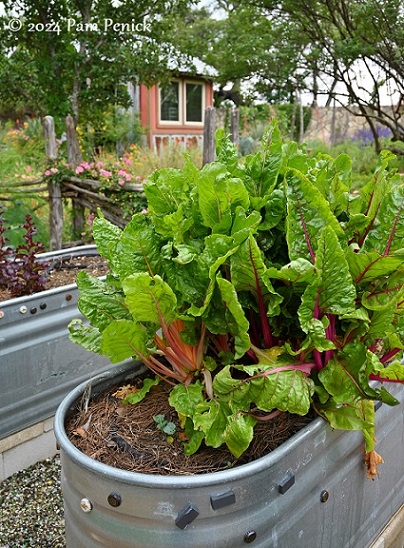
Rainwater collected from their two barn roofs is used to irrigate the garden, James told me, though most of the garden has low water needs.

Hesperaloe, roses, and pink evening primrose are pretty in pink.

Another framed view
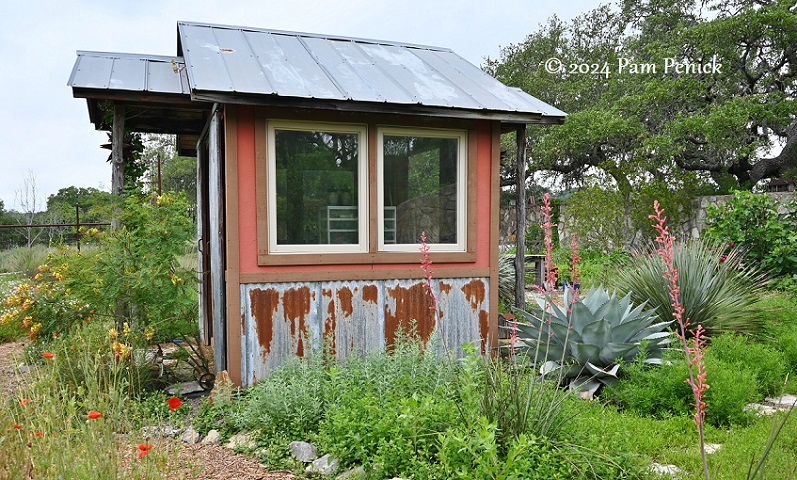
Side view of the shed with hardy bird-of-paradise, poppies, hesperaloe, agave, and sotol
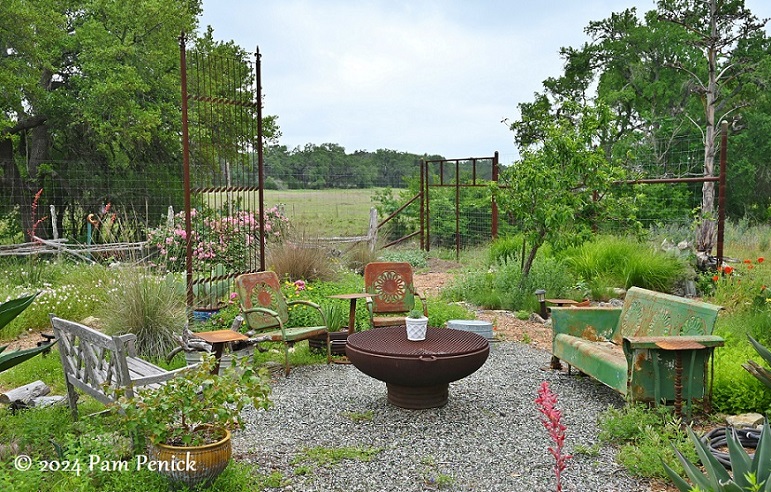
Back to the fire pit patio and the bucolic view beyond

Prickly pear and trellis detail

Red roses were just past peak but still blushing.

A tiny hoverfly zooms in to investigate.

After seeing the walled garden, we drove up to the house. A meadowy wildflower garden stretches along the foundation, fronted by a dry creek edged with limestone slabs.

Bluebonnets gone to seed have temporarily swallowed up the front walk. Steel pipes planted with hesperaloe make vertical accents.
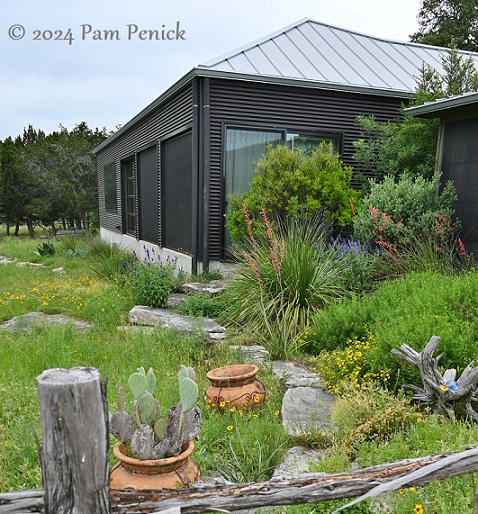
Around back, a garden that gets zero irrigation was in bloom with super-tough plants like hesperaloe, salvia, sotol, prickly pear, and plains coreopsis.
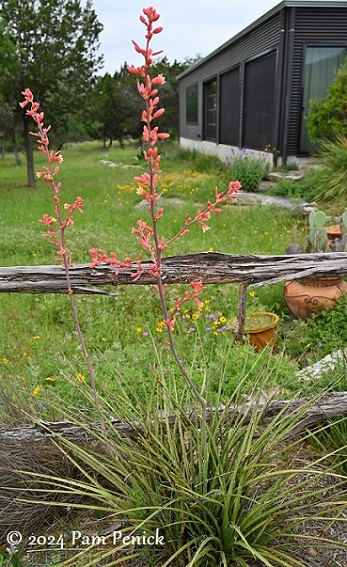
Hesperaloe bloom spike

Brilliant pink flowers perched atop a spiny hedgehog cactus, a dazzling sight.

What an enjoyable garden visit with beautiful plants and country charm! My thanks to James for sharing his lovely garden with me.
I welcome your comments. Please scroll to the end of this post to leave one. If you’re reading in an email, click here to visit Digging and find the comment box at the end of each post. And hey, did someone forward this email to you, and you want to subscribe? Click here to get Digging delivered directly to your inbox!
__________________________
Digging Deeper
May 11: Tour four Austin gardens on 5/11, from 9 am to 3 pm, on the Inside Austin Gardens Tour. Each garden “is created and cared for by a Travis County Master Gardener and demonstrates realistic gardening practices that inform and inspire.” Tickets are $25, or free for children 12 and under.
May 11: Save the date for Austin Home’s Great Outdoors Tour on 5/11.
May 18: Pop up to Dallas for the 2024 DCMGA Garden Tour on 5/18 from 10 am to 5 pm. Tickets are $18 if purchased online prior to 6 pm on 5/17, or $22 after 6 pm on 5/17 or at the event. For a sneak peek, click here.
June 1-2: Take a self-guided, 2-day tour of ponds and gardens in and around Austin on the annual Austin Pond and Garden Tour, held 6/1 and 6/2, 9 am to 5 pm. Tickets are $20 to $25.
Come learn about gardening and design at Garden Spark! I organize in-person talks by inspiring designers, landscape architects, authors, and gardeners a few times a year in Austin. These are limited-attendance events that sell out quickly, so join the Garden Spark email list to be notified in advance; simply click this link and ask to be added. Season 8 kicks off in fall 2024. Stay tuned for more info!
All material © 2024 by Pam Penick for Digging. Unauthorized reproduction prohibited.





